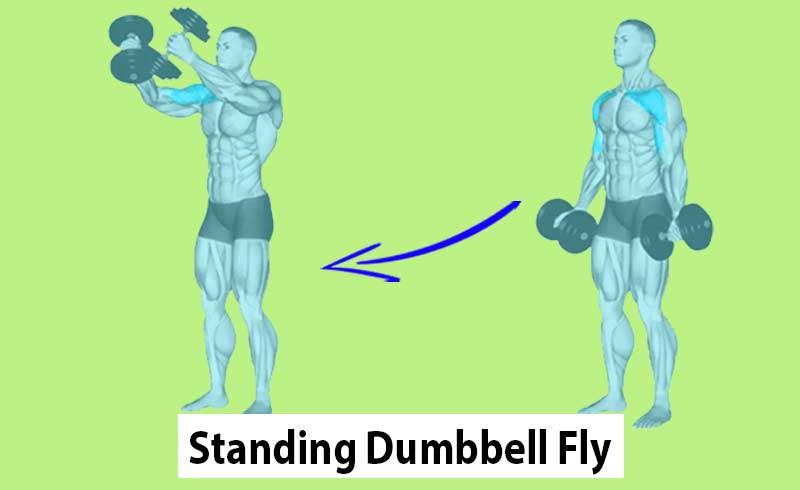When it comes to sculpting your upper pectoral, the standing dumbbell fly is one of the best gym exercises that can take your strength and aesthetics to the next level.
To ensure you’re making the most of this exercise, we will go over multiple sections in detail:
- What are dumbbell upward flyes
- Muscles it targets
- How to do it correctly
- Tips
- Common mistakes to avoid
- Alternate and variations
- Lateral raise vs standing db flye
Muscles Worked During the Standing Dumbbell Chest Fly
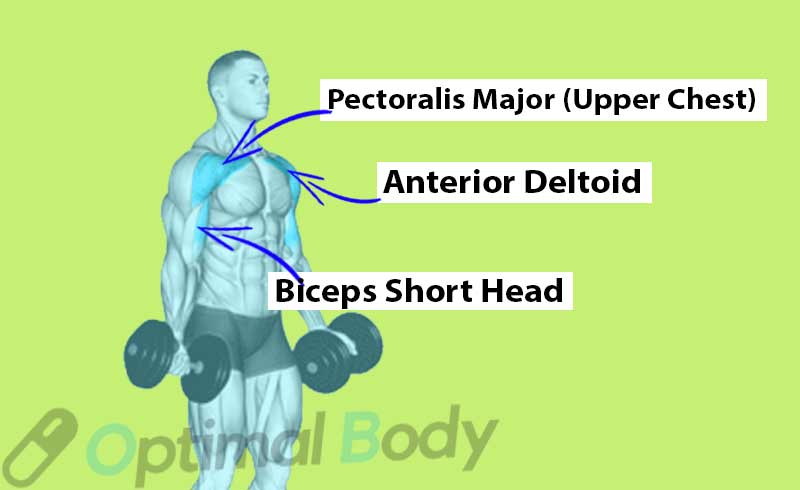
So, you want to know What does standing upward fly work? keep reading
The standing dumbbell fly targets three main muscle groups: your upper chest, and front deltoids.
Stabilizer muscles such as the biceps brachii, brachialis, triceps brachii, wrist flexors, obliques, and rectus abdominis also play a huge role in maintaining balance and form.
How To Do The Standing Dumbbell Fly
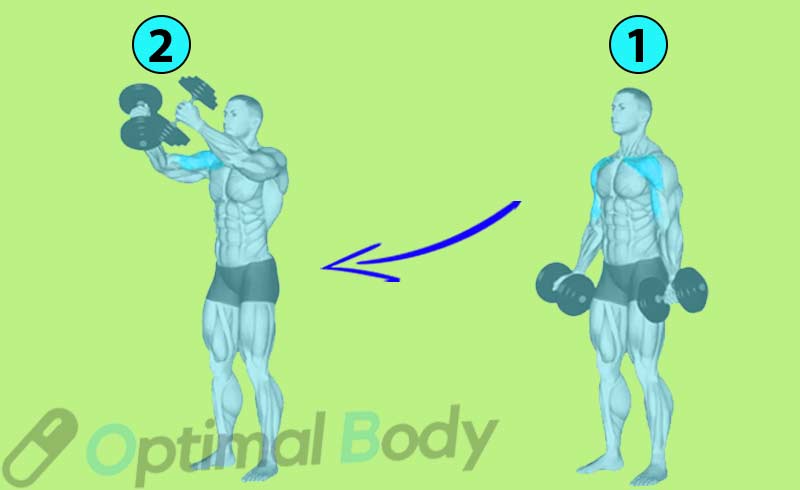
The Standing Dumbbell Chest Fly is a strength training exercise designed to target the upper and inner chest muscles.
It’s performed using dumbbells, which adds an extra dimension to the workout by requiring you to stabilize the weights throughout the movement.
Here are the 5 step by step instructions:
- Setup: Begin by standing upright, feet shoulder-width apart. Hold a dumbbell in each hand, palms facing upward. Allow your arms to hang straight down in front of you.
- Starting Position: Keep a slight bend in your elbows and position the dumbbells at hip level. Engage your core muscles gently for stability.
- Movement: Start the motion by raising the dumbbells upward and toward each other. This movement creates a semi-circular arc. Bring the dumbbells together at or slightly above shoulder level, ensuring they don’t touch at the top.
- Contraction and Return: At the peak of the movement, pause briefly, focusing on contracting your chest muscles. Slowly and with control, lower the dumbbells back to the starting position, following the same arc.
- Breathing: Exhale as you lift the dumbbells and inhale as you lower them.
Exercise Tips for More Benefits
- Focus on Form: Prioritize proper form over heavy weights. Engage your chest muscles by visualizing them contracting as you perform the movement.
- Controlled Movement: Slow and controlled motions yield better results. Aim for a consistent tempo during both the concentric and eccentric phases of the exercise.
- Full Range of Motion: Ensure a full range of motion by allowing your arms to spread comfortably and then bringing them together, feeling the stretch in your chest.
- Beginners should start with lighter weights and gradually increase as they become stronger.
- Hold the contracted position (top of the movement) for a second to maximize muscle engagement.
Common Mistakes to Avoid during Low To High Dumbbell Flye
- Using Excessive Weight: One common mistake is selecting weights that are too heavy. This can compromise your form and put unnecessary strain on your shoulders and back.
- Overarching your Back: Arching your back excessively can lead to strain and potential injury. Keep your core engaged and maintain a neutral spine throughout the movement.
- Speeding Through Reps: Performing reps too quickly can lessen the effectiveness of the exercise. Focus on controlled movements, feeling the stretch and contraction in your chest muscles.
Best Standing Dumbbell Fly Variations
Standing Single Arm Dumbbell Chest Flyes involve executing a fly motion using a dumbbell while standing.
Unlike the traditional bilateral fly exercise where both arms move simultaneously, this exercise focuses on working one arm at a time.
How to Perform Standing Single-Arm Dumbbell Flyes:
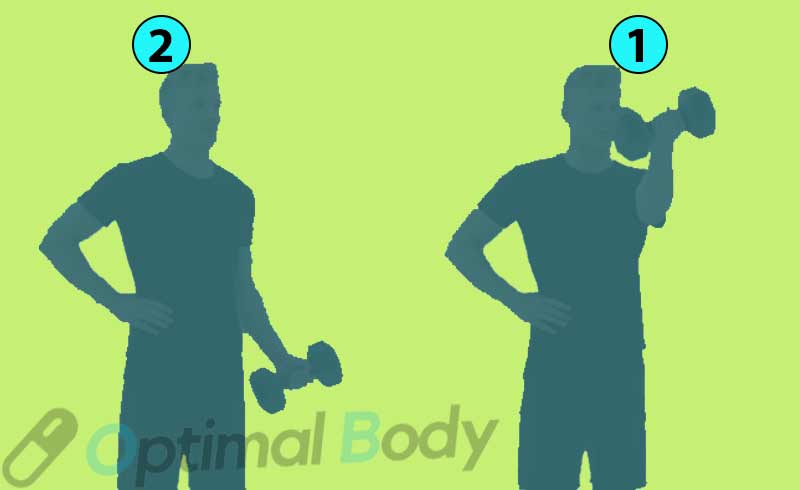
- Stand with feet shoulder-width apart.
- Hold a dumbbell in one hand with your arm extended.
- Keep your back straight and core engaged.
- Lift the dumbbell to shoulder level or slightly higher.
- Slowly lower it back to the starting position.
- Do the desired reps on one arm before switching.
Benefits:
- Muscle Balance: It helps correct muscle imbalances between your left and right sides.
- Range of Motion: Offers a greater range of motion and flexibility for your chest and shoulders.
- Isolated Engagement: Targets your chest and shoulder muscles more specifically.
Tips:
- Choose a dumbbell weight that challenges you but still allows you to maintain proper form throughout the exercise.
- Keep a slight bend in your elbow to avoid locking it out, which can strain the joint.
- Focus on controlled movements and avoid using momentum or swinging the weight to ensure accurate muscle engagement.
Top Dumbbell Standing Chest Flyes Alternatives
If you’re looking to switch things up or cater to your fitness level, consider these alternatives:
But, wait, before we dive deeper into the best alternatives for standing upward chest exercises, it’s important to mention what makes an exercise a suitable replacement:
- Isolation of Muscle Groups: The chosen exercise should isolate the targeted muscle groups.
- Activation of Chest Muscle Groups: The alternative should engage the chest muscles similar to the low dumbbell fly.
- Extended Range of Motion: It should provide a longer range of motion.
1. Incline Dumbbell Squeeze Press:
Also known as Close-Grip Incline Dumbbell Press or Incline Crush Press.
The incline dumbbell squeeze press is a highly effective chest pressing exercise, targeting the upper and inner chest areas.
During this movement, you keep the dumbbells in constant contact with each other, actively squeezing them inward throughout the press.
How to do incline squeeze presses?
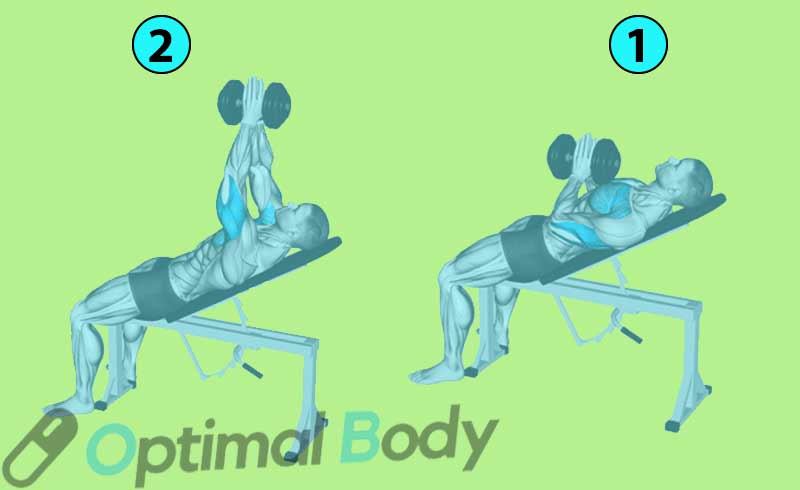
- Choose a pair of dumbbells that you can control throughout the movement.
Sit on the incline bench, ensuring your back is comfortably supported. - Hold a dumbbell in each hand with an overhand grip (palms facing away from your body).
Extend your arms straight up above your chest, with your palms facing each other. - Actively squeeze the dumbbells together as hard as you can.
- Slowly lower the dumbbells towards your upper chest, maintaining the squeezing action.
Keep your elbows slightly below your shoulders to ensure optimal chest engagement.
Continue the squeeze as you press the dumbbells back up to the starting position. - Repeat.
Benefits:
- Inner and Upper Chest Targeting: Focuses on the inner and upper chest areas.
- Better Muscle Activation: The squeezing action engages chest muscles intensely.
- Full Range of Motion: Provides a full chest contraction through the press.
Tips:
- Keep the dumbbells in contact and actively squeeze them together throughout the movement.
- Use appropriate weights to maintain control and form.
2. Incline Dumbbell Flye:
The incline dumbbell fly is a valuable alternative to the standing dumbbell fly, it stands as one of the premier upper chest exercises, making it a vital component of upper pec workouts.
The incline bench angle allows for focused and intense isolation of the upper pectoral muscles.
How to Do It:
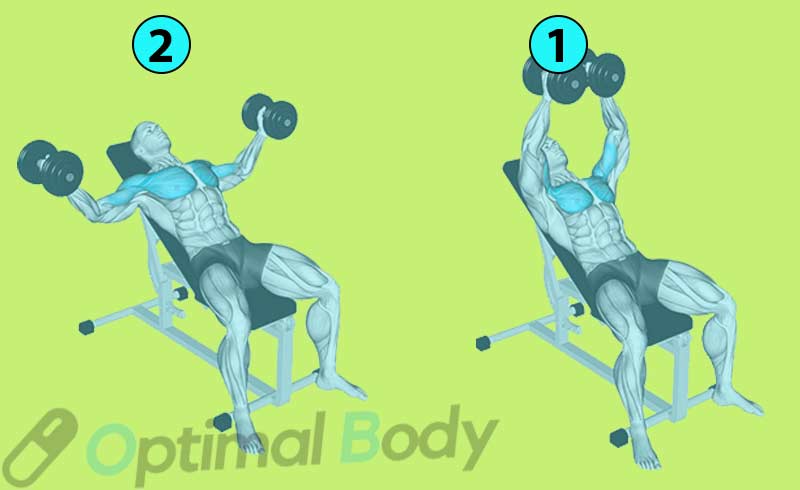
- Lie on an incline bench, set at around 30-45 degrees.
- Hold a dumbbell in each hand with arms extended above your chest.
- Bend your elbows slightly and open your arms wide, maintaining a slight bend.
- Lower the dumbbells outward and downward until your chest feels a stretch.
- Bring the dumbbells back up, squeezing your chest muscles.
- Repeat for the desired amount of reps.
Benefits:
- Upper Chest Isolation: Specifically targets the upper pectoral muscles.
- Enhanced Upper Chest Development: Effective for a well-rounded upper chest appearance.
- Variable Angles: Allows for different incline bench angles to modify intensity.
Tips:
- Use a controlled motion to avoid straining shoulders.
- Mix both flat and incline fly variations for comprehensive chest development.
3. Pec Deck Machine Flys:
As a machine-guided exercise, the pec deck fly is beginner-friendly. Its fixed movement path encourages a solid mind-muscle connection, emphasizing continuous contraction throughout the range of motion.
How to do machine flyes?
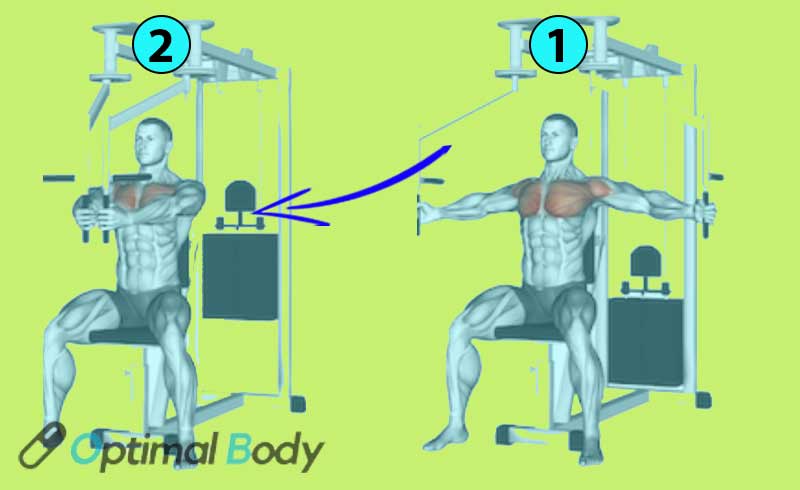
- Adjust the pec deck machine’s seat to align handles with shoulder level.
- Grip the handles with neutral palms.
- Slightly push out your chest.
- Bring hands together while keeping elbows slightly bent.
- Contract pecs at the top, then return to start.
Benefits:
- Fixed Movement Path: Simplifies movement for beginners.
- Mind-Muscle Connection: Helps establish a strong connection with pectoral muscles.
- Uniform Contraction: Encourages uniform muscle contraction throughout the exercise.
Tips:
- Adjust the machine settings for proper alignment with shoulder level.
- Maintain proper posture and avoid rounding your shoulders.
- Maintain pinched shoulder blades for enhanced muscle tension.
4. Standing Low To High Cable Fly:
This exercise closely mirrors the standing dumbbell fly. Using cables, it maintains consistent tension on the muscles across the entire range of motion.
How to do cable low to high flyes?
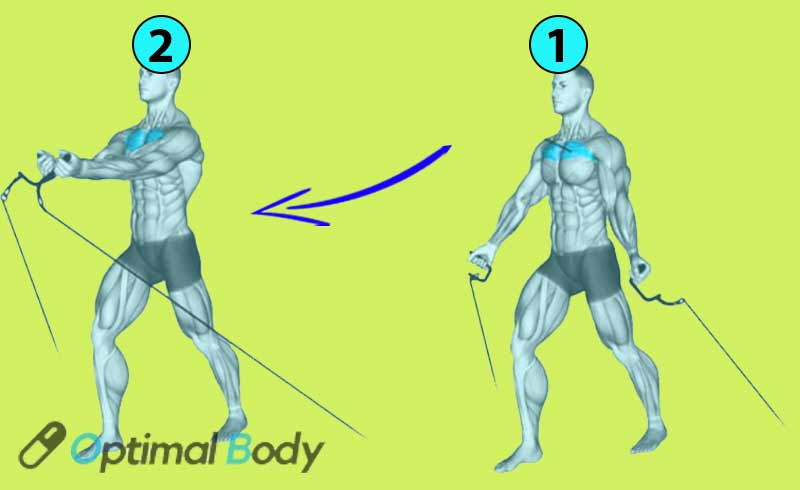
- Set cable pulleys at the lowest position with D-handle attachments.
- Hold a handle in each hand, step forward, and ensure tension in the cables.
- Start with hands at thigh level.
- Lift arms to shoulder height, maintaining a slight elbow bend.
- Contract pecs and then slowly return to starting position.
Benefits:
- Constant Tension: Maintains muscle tension throughout the range of motion.
- Cable Versatility: Offers diverse cable attachment options for variety.
- Muscle Isolation: Isolates chest muscles without involving other muscle groups.
Tips:
- Choose appropriate cable weights to avoid over-straining.
- Control the movement and focus on th1e chest contraction.
Push-Ups: An effective bodyweight exercise that engages your chest, shoulders, and triceps.
Chest Press Machine: Offers stability and control while targeting the same muscle groups.
Bench Press: A classic compound movement that builds overall upper body strength.
Standing Dumbbell Fly Vs Lateral Raise: Which Is Right for You?
While the standing dumbbell flies and lateral raises both target the shoulders, they have distinct differences:
Targeted Muscles:
The standing upward dumbbell flye primarily focuses on the chest muscles, specifically the pectoralis major.
In this exercise, the shoulders and triceps play a supportive role.
On the other hand, the lateral raise isolates the lateral deltoid muscles located on the sides of the shoulders.
This exercise aims to achieve wider and more rounded shoulders, contributing to a balanced upper body appearance.
Range of Motion:
When performing the upward standing fly, you engage in a broader range of motion. This movement involves stretching and squeezing the chest muscles as the arms move from a wider to a more contracted position.
In contrast, the lateral raise has a shorter range of motion. The main action is lifting the arms out to the sides, specifically targeting the lateral deltoids.
Exercise Mechanics:
The standing flye is commonly executed standing, incorporating horizontal arm movement. This movement pattern resembles actions like hugging or pushing.
On the other hand, the lateral raise can be performed while standing or sitting, with the primary motion being the lifting of the arms directly out to the sides.
Weights Used:
For the standing dumbbell flys, heavier weights can be used due to the emphasis on chest muscles. they require strength and stability in the chest area.
Conversely, the lateral raise requires lighter weights as the lateral deltoid muscles are smaller and more prone to fatigue with heavier loads.
Joint Stress:
Engaging in the standing fly can place stress on the shoulder joints, particularly because of the wider range of motion involved.
On the other hand, the lateral raises put less stress on the shoulder joints, making it a preferable choice for individuals with existing shoulder concerns.
Functional Focus:
The upward fly mimics movements like hugging, which have some degree of functional relevance in daily activities.
The lateral raise, while offering less direct functional application, effectively isolates specific shoulder muscles and contributes to overall shoulder aesthetics.
Variety in Routine:
Incorporating the standing dumbbell flie adds variety to chest and shoulder workouts, offering a different angle of muscle engagement.
Likewise, the lateral raise diversifies shoulder workouts, isolating and targeting the lateral deltoids for a comprehensive shoulder routine.
Summary:
The standing dumbbell fly is a versatile exercise that can significantly enhance your upper body strength and aesthetics.
References:
- Wilk, Michal et al. “Contrast Tempo of Movement and Its Effect on Power Output and Bar Velocity During Resistance Exercise.” Frontiers in physiology vol. 11 629199. 20 Jan. 2021, doi:10.3389/fphys.2020.629199
- Schoenfeld, Brad J, and Jozo Grgic. “Effects of range of motion on muscle development during resistance training interventions: A systematic review.” SAGE open medicine vol. 8 2050312120901559. 21 Jan. 2020, doi:10.1177/2050312120901559
- Gordon, Rebecca, and Saul Bloxham. “A Systematic Review of the Effects of Exercise and Physical Activity on Non-Specific Chronic Low Back Pain.” Healthcare (Basel, Switzerland) vol. 4,2 22. 25 Apr. 2016, doi:10.3390/healthcare4020022
- Bench Press Calculator - April 22, 2024
- Press to Handstand: Ultimate Step-by-Step Guide - April 22, 2024
- Cable Press (How To Do, Benefits, Targeted Muscles, Alternative) - April 22, 2024

